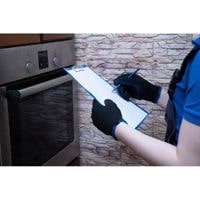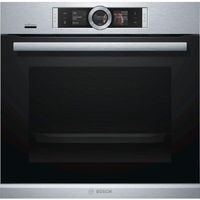Bosch Oven Not Heating. A Bosch oven that isn’t healing like it should feel defeated, but not necessarily something to worry too much about.
Fortunately, we can get to the bottom of exactly what’s going on in there with our handy Bosch oven troubleshooting guide.
From a lack of power to a blown thermal fuse, we’ve got all of your Bosch oven heating problems covered.
From it feeling like it’s not doing anything at all to there being no heat whatsoever, a Bosch oven not heating properly can feel like the worst-case scenario.
However, if you know where to start you’ll be able to find help for the majority of the issues before they have time to mess up your planned recipe from beginning to end.
Bosch Oven Not Heating

In this article, we discuss some of the problems with Bosch ovens that do not heat up.
Issue With Safety Valve
A gas oven safety valve and an oven igniter work together to supply gas to the burner.
A malfunctioning safety valve prevents the oven from heating. This problem is rare, however.
Replace the safety valve only after testing all of the more commonly defective components, especially those relating to heating; for instance, make sure that the igniter is properly extinguished.
Using a multimeter, test that continuity exists between the two points in the gas safety valve system
if all of the other heating components are working properly and your igniter lights up when you operate your main switch correctly. Replace this system if there is no continuity anywhere.
Relay Board Problem
There are some ovens that come with a relay board built into the cabinet. A relay board contains several relays that are responsible for allowing electricity to flow to the heating element of your oven.
In the event that one or more of the relays on this circuit board has failed, then your oven will not heat. Replacing a defective relay board is a simple and efficient way to get your oven functioning again.
Control Board For Ovens
There are relays on the control board of an oven that sends voltage to bake and broil circuits in response to user settings and sensor input.
Test the heating components or these elements that convert energy into heat before replacing the control board.
Defective Thermal Fuse
The ovens of restaurants and bakeries are not the only appliances susceptible to overheating. Stay informed by buying a quality oven thermometer that displays the actual temperatures inside your own kitchen.
If your oven gets too hot, the thermal fuse will trip, then your power to that specific section of the oven will be diverted elsewhere.
You won’t be able to use that part of your oven until you reset the fuse yourself; if it blew as a result of an accident or otherwise, then you may need to replace it altogether. If you blow this important fuse unintentionally, it can be dangerous!.
Cause With Broil Element
The broil element should be inspected for holes or blisters. It is essential that you check it for continuity as we saw in the video if it is consistently glowing red.
After the element first glows red, it may not glow after testing, in which case you will likely need to replace your broil element as the result of a burnout, which can be detected by a physical characteristic of the electrical parts themselves.
Broil Or Bake Spark Electrodes
For bake & broil burner ignition, a spark electrode is used to ignite the gas. The spark electrode sits right next to the burner, acting as a spark plug.
Power is applied to it and the spark from the electrode tip jumps to an electrode shield, igniting the gas inside of said burner compartment.
In the absence of this spark, the porcelain housing or electrode tip may be at fault. Turn on your range and make sure there’s an audible sound once you turn on the burner.
There may be a problem with your ground or something wrong with your electronics, such as a blown fuse if you don’t hear anything from your emitter. Check any exposed wiring to figure out what went wrong – and replace the fuse if needed.
Faulty Bake Element
When the bake element glows, this indicates that it’s heating up properly. If the element does not glow or glows dimly, there might be a problem with your appliance.
The most likely cause for a dim glow is if your bake element has burned out. Inspect the bake element for holes or blisters, as this usually means that the stove’s heating element is damaged.
If your bake element has continuity, it’ll be resistant to electricity when a multimeter is connected between its two ends.
If one of your bake elements has no continuity, replace it. To see if your oven has at least two working bake elements, check them with a multimeter.
Related Guides

